Have you ever walked into a room full of talented individuals and wondered why they can’t seem to work together effectively? Or maybe you’ve been handed the reins to a team and thought, “Now what?”
You’re not alone. The gap between managing people and actually leading them is vast, and it swallows good intentions every day.
After 24+ years navigating the evolving world of Leadership & Team Building, I’ve learned this: Great leadership isn’t about having all the answers. It’s about asking better questions and creating environments where people want to bring their best selves to work.
This guide cuts through outdated theory and buzzwords. It’s a modern roadmap for anyone looking to lead teams that don’t just perform, they thrive.
The Evolution of Leadership: From Command to Collaboration
Remember when leadership meant having the corner office and making unilateral decisions? Those days are long gone. The modern workplace has undergone a seismic shift that many leaders struggle to adapt to.
The Leadership Paradigm Shift
When I first stepped into a management role in 2000, the leadership playbook was straightforward: set clear expectations, monitor performance, provide feedback, and course-correct as needed. It was a linear, top-down approach that worked reasonably well in predictable environments.
Fast forward to today, and that approach feels as outdated as a flip phone.
According to a McKinsey study, 75% of employees cite their boss as the most stressful aspect of their job. Yet simultaneously, Gallup research shows that managers account for at least 70% of the variance in employee engagement scores.
This paradox perfectly illustrates the challenge of modern leadership: your approach matters more than ever, but the old models simply don’t cut it anymore.
Today’s effective leaders have evolved from:
- Commanders to Coaches: Dictating tasks has given way to developing talent
- Decision-makers to Facilitators: Leaders have shifted from making unilateral decisions to facilitating collaborative problem-solving.
- Managers of Work to Leaders of People: The focus has shifted from tracking outputs to nurturing human potential
- Timekeepers to Energy Architects: Managing hours and schedules has evolved into designing rhythms and environments that sustain focus, well-being, and team momentum.
- Experts to Learners: Rather than positioning themselves as the sole source of truth, today’s leaders model curiosity, embrace uncertainty, and grow alongside their teams.
The most successful leaders I’ve worked with don’t just adapt to this evolution. They embrace it as their competitive advantage.
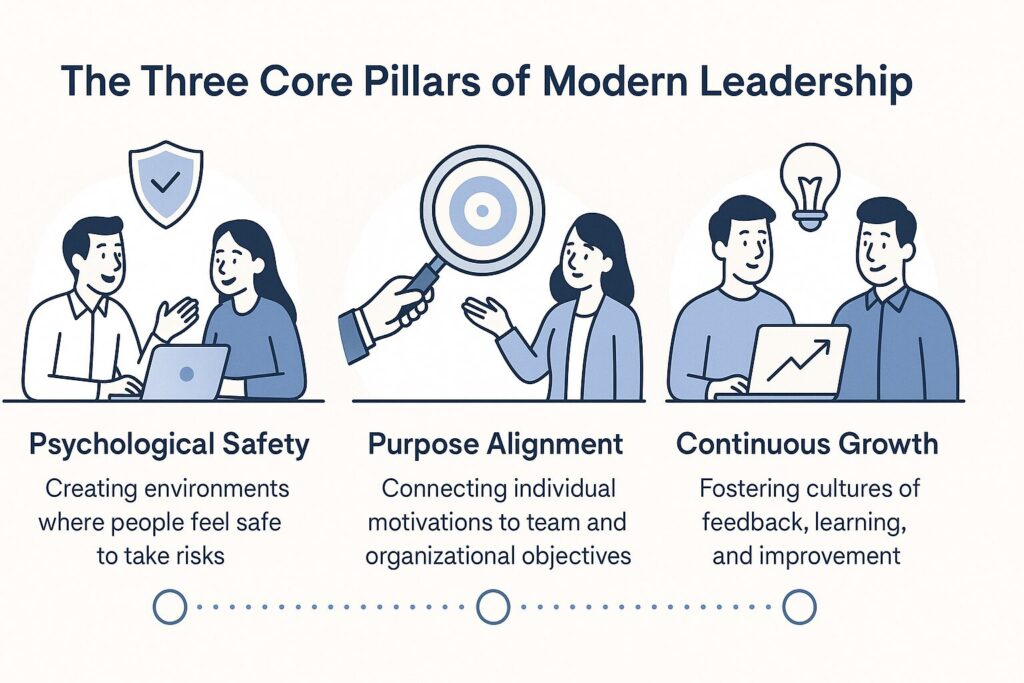
The Three Core Pillars of Modern Leadership
Based on my experience leading teams across startups and Fortune 500 companies, I’ve distilled modern leadership down to three fundamental pillars:
- Psychological Safety: Creating environments where people feel safe to take risks, speak up, and be vulnerable
- Purpose Alignment: Connecting individual motivations to team and organizational objectives
- Continuous Growth: Fostering cultures of feedback, learning, and improvement
Let’s unpack these essential pillars before diving into the tactical frameworks that bring them to life.
Pillar 1: Psychological Safety – The Foundation of High-Performance Teams
Google’s landmark Project Aristotle research identified psychological safety as the most critical factor in high-performing teams. But what exactly does that mean in practice?
Psychological safety is the shared belief that a team is safe for interpersonal risk-taking. It’s not about being nice or lowering standards, it’s about creating an environment where:
- People speak up without fear of embarrassment
- Leaders treat mistakes as learning opportunities.
- We actively seek out diverse perspectives.
- Challenging the status quo is encouraged.
I learned this lesson the hard way. Early in my leadership career, I prided myself on running “efficient” meetings where we stayed relentlessly on topic and made quick decisions. I didn’t realize that my approach was silencing valuable voices and perspectives.
It wasn’t until a team member pulled me aside after watching half our team disengage that I realized my “efficiency” was sabotaging our effectiveness. The strongest ideas weren’t surfacing because people didn’t feel safe enough to share half-formed thoughts or challenge conventional wisdom.
Building Psychological Safety: The CARE Framework
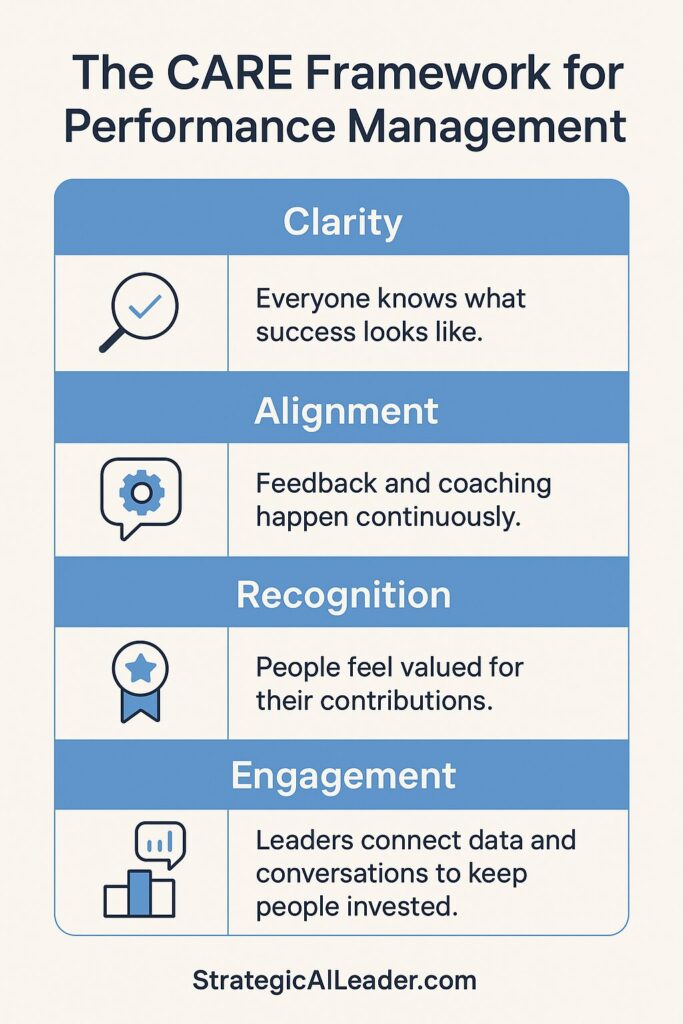
created by StrategicAILeader.com.
Clarity
- Set clear expectations for respectful dialogue and idea sharing.
- Define what “safe to speak up” looks like in practice.
- Make accountability visible so everyone knows how feedback will be used.
- Explain decision-making processes so outcomes don’t feel arbitrary.
- Provide transparent follow-up on how input shaped the final direction.
Accessibility
- Be available beyond formal meetings for informal check-ins.
- Share personal stories that show vulnerability and openness.
- Offer multiple communication channels to fit different styles.
Recognition
- Acknowledge contributions publicly and specifically, not just with a quick “good job.”
- Celebrate process and learning, not only outcomes.
- Highlight behind-the-scenes work that strengthens team trust.
Engagement
- Listen actively before problem-solving.
- Check assumptions and validate emotions.
- Slow down during tension and show presence over precision.
- Encourage dissenting views and make space for constructive disagreement.
Takeaway: When leaders practice CARE, teams experience psychological safety. That safety builds confidence, encourages risk-taking, and creates a cycle of stronger performance.
Pillar 2: Purpose Alignment – Connecting Individual Motivation to Collective Goals
I once inherited a team with an all-star roster of talent. On paper, we should have been unstoppable. In reality, we were a collection of individuals rowing in different directions.
The missing ingredient? A shared sense of purpose that connected individual motivations to our collective goals.
Purpose alignment isn’t about manufacturing inspiration through motivational posters or company values statements. It’s about the honest, sometimes messy work of understanding what drives each person on your team and finding the authentic connections between those drivers and your team’s objectives.
According to Harvard Business Review, companies with a strong sense of purpose outperform the market by 5-7% annually. However, the real magic happens when organizational purpose intersects with individual purpose.
The Personal Purpose Matrix
The Personal Purpose Matrix is one of the most powerful tools I’ve developed for purpose alignment. This simple but effective framework helps uncover what truly motivates each team member: Did I mention, I love frameworks!
| Dimension | Key Questions |
| Values | What principles guide your decisions? What are your non-negotiables? |
| Strengths | What comes naturally to you? Where do you lose track of time? |
| Impact | What change do you want to see in the world? How do you want to contribute? |
| Growth | What do you want to master? What skills are you eager to develop? |
By having authentic conversations around these dimensions with each team member, you can identify where individual purpose and team objectives naturally align, and where you might need to build bridges.
For example, I once worked with a brilliant engineer who seemed disengaged from our team’s customer-facing product work. Through a purpose alignment conversation, I discovered his deep personal commitment to mentorship and knowledge-sharing. We restructured his role to include leading our engineering guild program, which satisfied his purpose while still delivering on our product goals. His engagement skyrocketed, and our team benefited from his renewed energy.
Aligning Through Storytelling
Once you understand individual motivations, the next challenge is weaving them into a cohesive team narrative. Here’s where the power of leadership storytelling comes into play.
Effective purpose-driven leaders:
- Connect the dots: Explicitly link individual contributions to team outcomes and organizational impact
- Humanize the work: Share customer stories that illustrate the real-world impact of your team’s efforts
- Celebrate alignment: Recognize moments when individual purpose and team goals create positive outcomes
- Revisit regularly: Make purpose alignment an ongoing conversation, not a one-time exercise
Remember, purpose alignment isn’t about manipulating people to care about your goals. It’s about genuinely understanding what matters to them and finding the authentic intersections with what matters to the team.
Pillar 3: Continuous Growth – Building Learning Organizations
According to the World Economic Forum’s Future of Jobs Report 2025, employers anticipate that 39% of workers’ core skills will change by 2030, underscoring the ongoing need for continuous learning and reskilling initiatives.
In this environment, the most valuable teams aren’t necessarily those with the most skills today; they’re the ones that learn fastest. As a leader, your job is to create the conditions where continuous learning becomes part of your team’s DNA.
The Growth Flywheel
Continuous growth operates as a flywheel that, once properly initiated, generates its momentum:
- Feedback loops: Create mechanisms for regular, specific, and actionable feedback
- Psychological safety: Ensure people feel safe to experiment and occasionally fail
- Learning resources: Provide access to tools, time, and training for growth
- Application opportunities: Create spaces to apply new skills in meaningful ways
- Recognition: Celebrate learning and growth, reinforcing the cycle
Each element reinforces the others, creating a self-sustaining engine for team development.
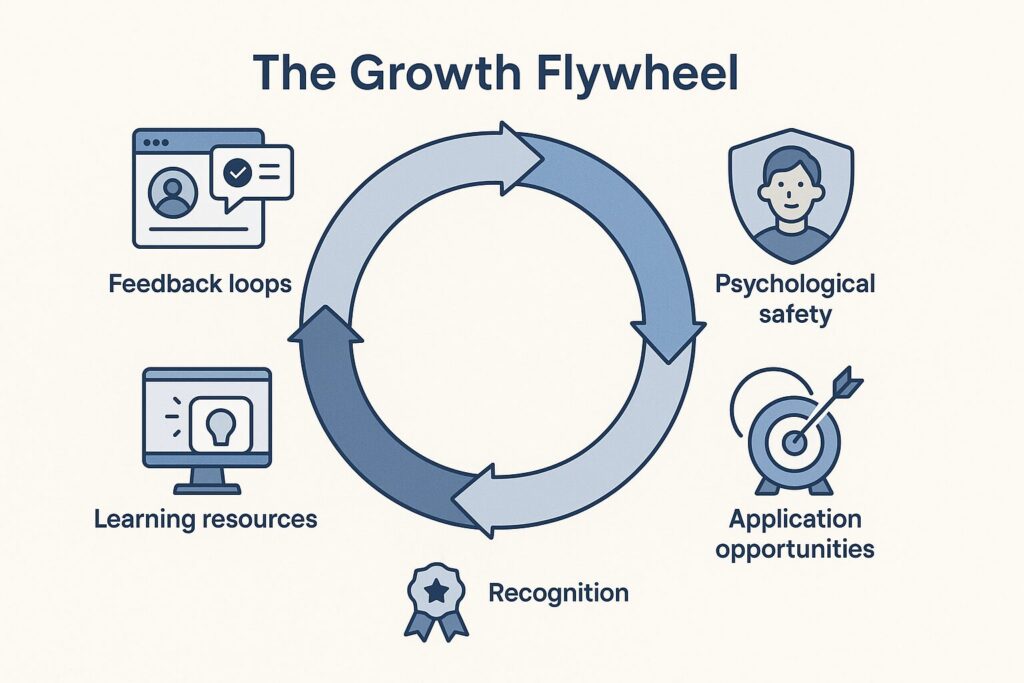
Building Effective Feedback Loops
Feedback is the fuel that powers the growth flywheel, but most organizations struggle to develop healthy feedback cultures. In my experience, the most effective approach is the FAST feedback framework:
Frequent
- Don’t wait for annual reviews or monthly 1:1s; feedback should be ongoing.
- Provide real-time input when observations are still fresh and actionable.
- Normalize feedback as a daily part of team culture, not a special event.
- Encourage feedback in all directions – up, down, across teams and functions.
- Use team retros, stand-ups, or project debriefs to integrate regular feedback moments.
Actionable
- Focus on specific, observable behaviors, not vague or personal traits.
- Offer straightforward suggestions on what to start, stop, or continue.
- Link feedback to tangible goals or performance outcomes.
Specific
- Avoid general praise or criticism – go beyond “good job” or “needs work.”
- Reference concrete examples, using phrases like “I noticed that…”
- Tie observations to team norms, KPIs, or company values.
- Highlight how the behavior affected others or the work product.
Timely
- Deliver feedback as close to the behavior as possible to maximize impact.
- Build immediate reflection time into sprints, meetings, or milestones
- Don’t let “perfect” get in the way of “prompt” – even short feedback is valuable.
- Reinforce good behaviors immediately to increase retention and morale.
- Use time-bound tools like weekly feedback rounds or Slack check-ins to keep consistency.
I once worked with a leader who transformed her team’s performance by implementing “feedback Fridays,” a 30-minute block where team members paired up to exchange observations from the week. The structured time and expectation removed the awkwardness, and within months, continuous feedback became second nature across the team.
From Theory to Practice: Team-Building Frameworks That Work
Now that we’ve explored the three pillars of modern leadership, psychological safety, purpose alignment, and continuous growth, let’s translate these concepts into practical frameworks you can implement with your team.
The 30-60-90 Team Alignment Process
One of the most effective team-building frameworks I’ve developed is the 30-60-90 alignment process. This structured approach works particularly well for new teams or when significant changes occur:
First 30 Days: Foundation Building
- Conduct 1:1 purpose alignment conversations to understand each team member’s motivations, goals, and concerns.
- Establish team working agreements and communication norms to set expectations for collaboration, responsiveness, and meeting cadence.
- Define clear roles, responsibilities, and decision-making frameworks to reduce ambiguity and increase accountability.
- Map out key stakeholders and cross-functional relationships to ensure alignment beyond the team’s immediate boundaries.
- Diagnose current team health through surveys or informal check-ins to uncover strengths, gaps, and early tension points.
- Model transparency and psychological safety by sharing your leadership principles, communication style, and how you receive feedback.
Days 30-60: Strengthening Connections
- Facilitate structured team-building sessions that explore communication preferences, working styles, and conflict triggers.
- Implement regular retrospectives or feedback circles to identify and address emerging friction points in a safe environment.
- Create cross-functional or cross-role collaborations to encourage fresh thinking and broaden internal networks.
- Recognize and amplify individual strengths by assigning stretch roles or peer-led initiatives that build mutual respect.
- Introduce shared rituals (like wins of the week, gratitude rounds, or peer shoutouts) to foster a culture of appreciation and cohesion.
Days 60-90: Accelerating Performance
- Co-create shared goals with visible metrics and celebrate key milestones to build momentum and accountability.
- Implement cross-training and role shadowing to increase team agility, build redundancy, and foster more profound empathy across functions.
- Establish structured feedback loops through 1:1s, peer reviews, or team retros to support continuous improvement.
- Launch individualized growth plans that align personal development goals with team and organizational priorities.
This phased approach prevents the common mistake of jumping straight to performance expectations before building the relational foundation needed for sustained success.
The TEAM Canvas Exercise
For teams that need to align around shared purpose and working styles quickly, I recommend the TEAM Canvas exercise – a powerful visual tool that gets everything on the table. Original creator, Ivanov, A. (2016). The Team Canvas: A tool for team alignment and performance.
- Purpose: Why does this team exist? What impact are we trying to create?
- Values: What principles guide our work and interactions?
- Strengths: What unique capabilities does each team member bring?
- Needs: What does each person need to do their best work?
- Constraints: What limitations or challenges must we navigate?
- Goals: What specific outcomes are we working toward?
- Roles: Who is responsible for what aspects of our work?
- Norms: How will we work together, communicate, and make decisions?
- Metrics: How will we measure success?
Facilitating this canvas creation as a team activity produces a valuable reference document and generates the conversations needed to build understanding and alignment.
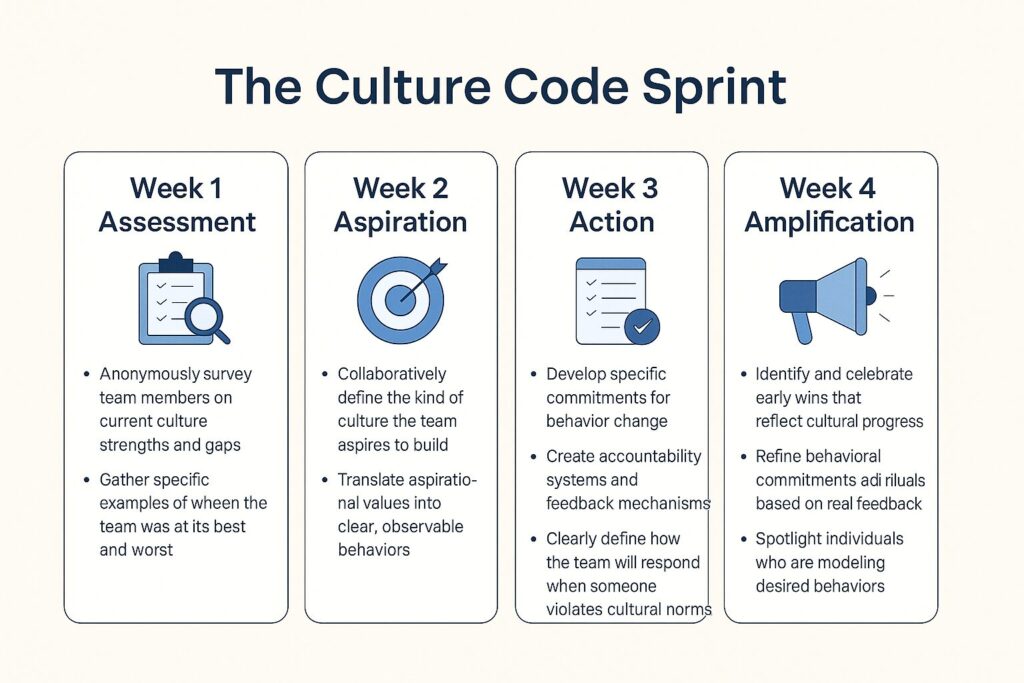
The Culture Code Sprint
For established teams looking to level up their performance, the Culture Code Sprint provides a framework for intentionally shaping team culture:
Week 1: Assessment
- Anonymously survey team members on current culture strengths and gaps.
- Gather specific examples of when the team was at its best and worst.
- Identify the gap between espoused values and actual behaviors.
Week 2: Aspiration
- Collaboratively define the kind of culture the team aspires to build.
- Translate aspirational values into clear, observable behaviors.
- Prioritize two to three focus areas that will have the most immediate impact.
- Ensure alignment with organizational values and business goals.
Week 3: Action
- Develop specific commitments for behavior change.
- Create accountability systems and feedback mechanisms.
- Clearly define how the team will respond when someone violates cultural norms.
Week 4: Amplification
- Identify and celebrate early wins that reflect cultural progress.
- Refine behavioral commitments and rituals based on real feedback.
- Spotlight individuals who are modeling desired behaviors.
- Document and share success stories internally to build momentum.
- Introduce lightweight rituals to reinforce and sustain the new culture.
This time-boxed approach creates momentum for culture change that often eludes more open-ended initiatives.
Leadership Challenges and How to Overcome Them
Even with solid frameworks in place, leadership challenges inevitably arise. Let’s address some of the most common obstacles and practical strategies to overcome them.
Remote and Hybrid Team Leadership
According to Buffer’s 2023 State of Remote Work report, 23% of remote workers identified loneliness as their biggest struggle, and 33% reported staying home too often due to a lack of reason to leave, indicating persistent challenges in communication, collaboration, and social connection within distributed teams.
To lead effectively in this environment:
- Create intentional connection points
- Schedule regular 1:1s with a mix of structured and unstructured time
- Establish team rituals that bring people together virtually
- Create opportunities for casual interaction that mimic office “water cooler” moments
- Optimize asynchronous communication
- Document decisions and discussions thoroughly
- Create clear expectations around response times and communication channels
- Use asynchronous updates to make synchronous meetings more valuable
- Balance autonomy and visibility
- Focus on outcomes rather than monitoring activities
- Create transparent dashboards for progress tracking
- Schedule regular demos or showcases to highlight work
- Address digital burnout proactively
- Establish clear boundaries around working hours
- Model healthy digital habits as a leader
- Create “meeting-free” blocks for focused work
I’ve found that the most successful remote leaders don’t try to replicate in-person experiences exactly – they leverage the unique advantages of distributed work while intentionally addressing its challenges.
Navigating Team Conflict
Conflict is inevitable in any team, but how it’s handled determines whether it becomes destructive or constructive. Recent research by The Myers-Briggs Company reveals that managers now spend over 4 hours per week dealing with conflict, a significant increase from previous years. Moreover, over a third (36%) of employees report dealing with conflict often, very often, or all the time, up from 29% in earlier studies. Poor communication remains the leading cause of workplace conflict, followed by lack of transparency and personality clashes.
To transform conflict from a productivity drain to a catalyst for growth:
- Differentiate between productive and toxic conflict
- Productive conflict focuses on ideas and approaches
- Toxic conflict becomes personal and emotional
- Your response should match the conflict type
- Address issues early
- Don’t let tensions simmer until they boil over
- Schedule regular temperature checks to address surface concerns
- Create “conflict resolution pathways” for escalation
- Facilitate, don’t adjudicate
- Resist the urge to impose solutions
- Help parties find their resolution
- Focus on interests beneath positions
- Extract learning from conflict
- Reflect on patterns that emerge across conflicts
- Identify system or process improvements that could prevent similar issues
- Celebrate constructive conflict resolution as a team win
I once inherited a team with deep-seated tensions between different functional groups. Rather than trying to solve the conflict directly, I created mixed-functional “innovation teams” focused on customer problems. The shared goal and fresh context allowed team members to build new relationships beyond their historical divides, gradually transforming the team dynamic.
Leading Through Uncertainty and Change
In today’s rapidly evolving business landscape, leaders face unprecedented challenges. According to Gartner’s 2024 insights, 73% of HR leaders report that their leaders and managers aren’t equipped to lead change. This highlights a significant gap in leadership development and underscores the need for organizations to invest in building change management capabilities among their leadership teams.
To navigate this effectively, leaders must adopt strategies that combine transparency, adaptability, clarity of purpose, and collective intelligence
1. Embrace Radical Transparency
- Separate what you know from what you don’t.
- Be transparent about both current knowledge and knowledge gaps.
- Avoid false certainty that undermines trust and credibility.
2. Maintain Clarity of Purpose with Tactical Flexibility
- Maintain strategic direction while allowing flexibility in execution.
- Keep core purpose and values constant as a stabilizing force.
- Support multiple paths to achieve shared objectives.
- Create rapid learning cycles to adapt based on evolving conditions.
3. Focus on Resilience, Not Just Prediction
- Build team capabilities that are durable across different scenarios.
- Use scenario planning to prepare for a range of potential futures.
- Develop contingency plans for critical vulnerabilities.
- Prioritize learning agility over forecasting precision.
- Encourage experimentation and iterative improvement.
4. Leverage Collective Intelligence
- Create psychological safety so team members feel safe raising concerns.
- Draw on diverse perspectives when making decisions in uncertainty.
- Distribute leadership authority to enable quicker, localized responses.
Real-World Application
During a particularly turbulent organizational restructuring, I maintained team cohesion by creating a “certainty vs. uncertainty” board. We regularly updated what we knew, what we expected, and what remained unknown.
A simple visual framework, highlighting what was within our control versus what wasn’t, helped the team stay focused on actionable steps while still acknowledging the reality of our situation. This approach not only preserved trust but also empowered the team to operate with clarity and confidence in ambiguity.
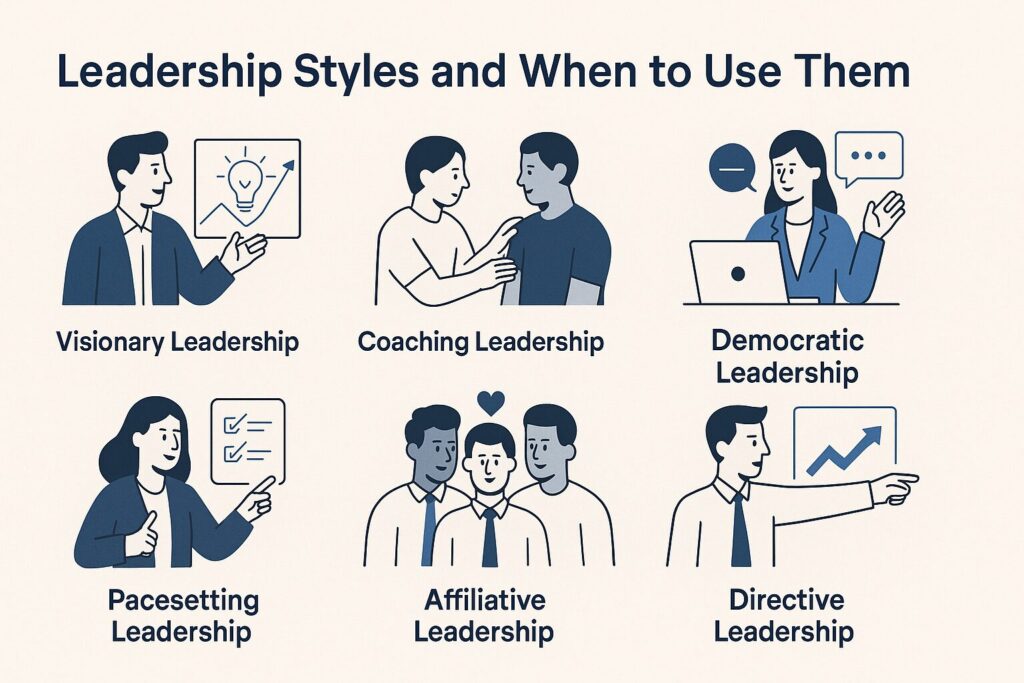
Leadership Styles and When to Use Them
No single leadership approach works in every situation. The most effective leaders develop a repertoire of styles they can deploy depending on context:
Visionary Leadership
- When to use it: During periods of significant change or when teams need renewed inspiration
- How it works: Paint a compelling picture of the future and connect it to current actions
- Key skills: Storytelling, strategic thinking, inspiring communication
Coaching Leadership
- When to use it: When developing team capabilities is the priority
- How it works: Ask powerful questions that help others discover their insights
- Key skills: Active listening, emotional intelligence, growth mindset
Democratic Leadership
- When to use it: When the team has relevant expertise, and buy-in is crucial
- How it works: Facilitate collaborative decision-making and inclusive discussion
- Key skills: Facilitation, balanced participation, synthesis of diverse perspectives
Pacesetting Leadership
- When to use it: In high-stakes situations requiring rapid results from capable teams
- How it works: Set high standards and exemplify the performance expected
- Key skills: Technical expertise, focus, clear expectations
Affiliative Leadership
- When to use it: During periods of stress or when team harmony needs rebuilding
- How it works: Prioritize emotional connections and team well-being
- Key skills: Empathy, relationship building, conflict resolution
Directive Leadership
- When to use it: In crises or with inexperienced team members needing guidance
- How it works: Provide explicit instructions and close oversight
- Key skills: Decisive action, clear communication, confidence
According to Daniel Goleman’s research, leaders who master four or more leadership styles, especially visionary, coaching, affiliative, and democratic, create the most positive team climates and deliver the best business results.
The key is knowing these styles and recognizing which situations call for which approach. I keep a simple framework: the more urgent the situation and the less experienced the team, the more directive I become; the more complex the challenge and the more capable the team, the more collaborative my approach.
Team Building Activities That Work
Let’s move beyond trust falls and escape rooms to team-building activities that deliver meaningful results:
Structured One-on-Ones
While not typically categorized as “team building,” intentionally designed one-on-ones form the foundation of strong teams:
- Career Journey Maps: Have team members share their professional journeys, highlighting pivotal decisions, lessons learned, and future aspirations
- Values Exploration: Discuss personal and professional values, exploring where they align and how they influence decision-making
- Working Preferences Exchange: Create structured discussions around work styles, communication preferences, and feedback approaches
These intentional conversations build the relational foundation for effective teamwork.
Team Retrospectives
Regular retrospectives provide structured opportunities for team learning and relationship building:
- Start/Stop/Continue: What should we start doing, stop doing, and continue doing?
- 3 Wins, 2 Challenges, 1 Insight: Reflect on successes, difficulties, and learnings
- Mountain/Valley Timeline: Visualize highs and lows over a specific period, analyzing patterns and triggers
When facilitated effectively, retrospectives build psychological safety while driving continuous improvement.
Strength-Based Activities
Activities that help team members recognize and leverage each other’s strengths build appreciation and collaboration:
- Strengths Spotting: Have team members identify and share specific strengths they’ve observed in each other
- Dream Team Design: Create hypothetical teams for different scenarios based on complementary strengths
- Skill-Sharing Sessions: Rotate facilitators for mini-workshops where team members teach their unique skills
These activities shift focus from fixing weaknesses to maximizing collective strengths.
Purpose-Driven Projects
Cross-functional projects with meaningful outcomes build relationships through shared purpose:
- Customer Immersion Experiences: Bring teams together to observe and interact with customers directly
- Innovation Challenges: Create time-boxed initiatives to solve specific customer or business problems
- Community Impact Projects: Collaborate on initiatives that benefit your broader community
These projects build relationships through shared meaningful experiences rather than artificial team-building exercises.
Measuring Leadership Effectiveness
How do you know if your leadership approach is working? Here are key metrics and methods to consider:
Quantitative Measures
- Employee Engagement Scores: Regular pulse surveys on key engagement dimensions
- Retention Rates: Tracking voluntary turnover, especially among high performers
- Team Performance Metrics: Objective measures of team output and quality
- Psychological Safety Indicators: Anonymous survey data on willingness to take risks and speak up
- Internal Mobility: Tracking promotion and development rates within your team
Qualitative Indicators
- Skip-Level Feedback: Structured conversations with your direct reports’ team members
- 360-Degree Reviews: Comprehensive feedback from peers, direct reports, and managers
- Team Retrospective Themes: Patterns that emerge from regular team reflections
- Exit Interview Insights: Candid feedback from departing team members
- Leadership Self-Assessment: Honest reflection on your growth and development
In today’s rapidly evolving business landscape, leaders face unprecedented challenges. According to Deloitte’s 2023 Global Human Capital Trends report, only 23% of organizations believe their leaders possess the necessary capabilities to effectively manage in a disrupted world. This highlights a significant gap in leadership development and underscores the need for organizations to invest in building change management capabilities among their leadership teams.
Conclusion: Your Leadership Journey
Leadership isn’t a destination, it’s a continual journey of growth and adaptation. The frameworks and approaches outlined in this guide provide a roadmap, but your unique leadership style will emerge through consistent practice and reflection.
As you build your leadership approach, remember three fundamental truths:
- People don’t care how much you know until they know how much you care. Technical expertise matters, but emotional intelligence is what distinguishes truly transformative leaders.
- Your impact as a leader multiplies through others. The measure of your success isn’t what you accomplish, but what you enable your team to achieve.
- Leadership is a service, not a status. The most effective leaders see their role as removing obstacles and creating conditions for others to succeed.
I’d love to hear about your leadership experiences and challenges. What frameworks have you found most effective? What obstacles are you currently navigating?
Please share your thoughts in the comments below, or connect with me on LinkedIn to continue the conversation.
And if you’re looking to dive deeper into specific aspects of leadership and team building, subscribe to our newsletter for weekly insights and actionable strategies you can implement immediately.
Additional Resources
For leaders ready to take their team-building skills to the next level:
- The Five Dysfunctions of a Team by Patrick Lencioni
- A foundational fable-based guide to diagnosing and resolving common team dysfunctions like lack of trust, fear of conflict, and accountability gaps.
- Leaders Eat Last by Simon Sinek
- Explores how great leaders build trust and loyalty by prioritizing their team’s well-being, supported by biology and real-world case studies.
- Team of Teams by General Stanley McChrystal
- Lessons from military leadership on how to break down silos and build adaptive, networked teams capable of thriving in complexity.
- The Culture Code by Daniel Coyle
- Investigates what makes high-performing teams click, offering practical guidance on psychological safety, vulnerability, and purpose.
- Radical Candor by Kim Scott – Free with Kindle Unlimited
- A guide to building strong relationships at work by caring personally while challenging directly, especially important for feedback-driven team cultures.
- Multipliers by Liz Wiseman – Free with Kindle Unlimited
- Explores how effective leaders amplify the intelligence and capability of those around them, and how accidental diminishers stifle it.
- No Rules Rules by Reed Hastings & Erin Meyer
- A deep dive into Netflix’s radical culture of trust and accountability, showing how culture can be a performance accelerator.
- The Fearless Organization by Amy C. Edmondson – Free with AudioBook Subscription
- A research-backed guide to creating psychological safety at work, the key to team learning, innovation, and resilience.
- Dare to Lead by Brené Brown
- Focuses on courage, vulnerability, and the emotional intelligence required for authentic and connected leadership.
- An Everyone Culture by Robert Kegan & Lisa Lahey
- Describes Deliberately Developmental Organizations (DDOs) where employee growth is woven into the fabric of daily work.
Leadership & Team Building – FAQ Section
What is the difference between managing and leading a team?
Managing focuses on planning, organizing, and executing tasks. Leading is about inspiring, aligning people with purpose, and unlocking potential. Modern professionals must master both, but sustainable performance comes from leadership.
How do I build trust within a newly formed team?
Start with psychological safety. Use the CARE framework, be curious, accessible, recognize effort, and lead with empathy. Early 1:1s, team agreements, and transparency are foundational to establishing trust.
What is psychological safety and why does it matter?
Psychological safety means team members feel safe to take risks, voice ideas, and admit mistakes without fear. According to Google’s Project Aristotle, it’s the #1 factor in high-performing teams.
How do I align team members with different motivations?
Use the Personal Purpose Matrix to uncover what drives each team member. Then, connect their motivations to team goals through storytelling, co-created goals, and tailored development paths.
How often should I give feedback to my team?
Frequently. Leverage the FAST framework—Feedback should be Frequent, Actionable, Specific, and Timely. Don’t wait for formal reviews; make feedback a daily ritual.
What leadership style is best for remote teams?
Coaching and visionary styles work best. Focus on asynchronous clarity, outcome-based expectations, and culture-building rituals. Over-communicate context, under-manage tasks.
How do I handle conflict in high-performing teams?
Normalize productive conflict by facilitating open dialogue. Distinguish between idea-based friction (good) and personal friction (bad). Use retrospectives, conflict frameworks, and set resolution norms early.
What’s the 30-60-90 Team Alignment framework?
A phased approach for building high-performing teams:
- Days 1–30: Build trust, clarify roles, align purpose.
- Days 30–60: Strengthen communication, introduce feedback loops.
- Days 60–90: Accelerate performance with shared goals and rituals.
What’s the best way to measure leadership effectiveness?
Use quantitative (engagement, retention, performance metrics) and qualitative (360 reviews, retrospectives, skip-level feedback). Look for consistency between team sentiment and business outcomes.
How do I lead during change or uncertainty?
Use radical transparency, clarity of purpose, and build resilience over prediction. Share what’s known vs. unknown, and involve the team in adaptive planning cycles.
How do I create a learning culture in my team?
Implement the Growth Flywheel: enable psychological safety, real-time feedback, access to learning, and celebrate small wins. Model curiosity and show that education is valued at every level.
Which leadership books are best for modern professionals?
Start with:
- Dare to Lead by Brené Brown
- The Culture Code by Daniel Coyle
- Radical Candor by Kim Scott
- Multipliers by Liz Wiseman
- The Fearless Organization by Amy Edmondson
Related Articles
Build a Team That Runs Without You, Proven Systems
From Manager to Leader: How I Unlocked Real Growth
About the Author
I’m Richard Naimy – a strategic advisor to founders and operating leaders navigating growth, complexity, and innovation. I write for ambitious professionals who want to build smarter, scale faster, and lead with clarity.
I write about:
- AI + MarTech Automation
- AI Strategy
- COO Ops & Systems
- Growth Strategy (B2B & B2C)
- Infographic
- Leadership & Team Building
- My Case Studies
- Personal Journey
- Revenue Operations (RevOps)
- Sales Strategy
- SEO & Digital Marketing
- Strategic Thinking
📩 Want 1:1 strategic support?
🔗 Connect with me on LinkedIn
📬 Read my playbooks on Substack
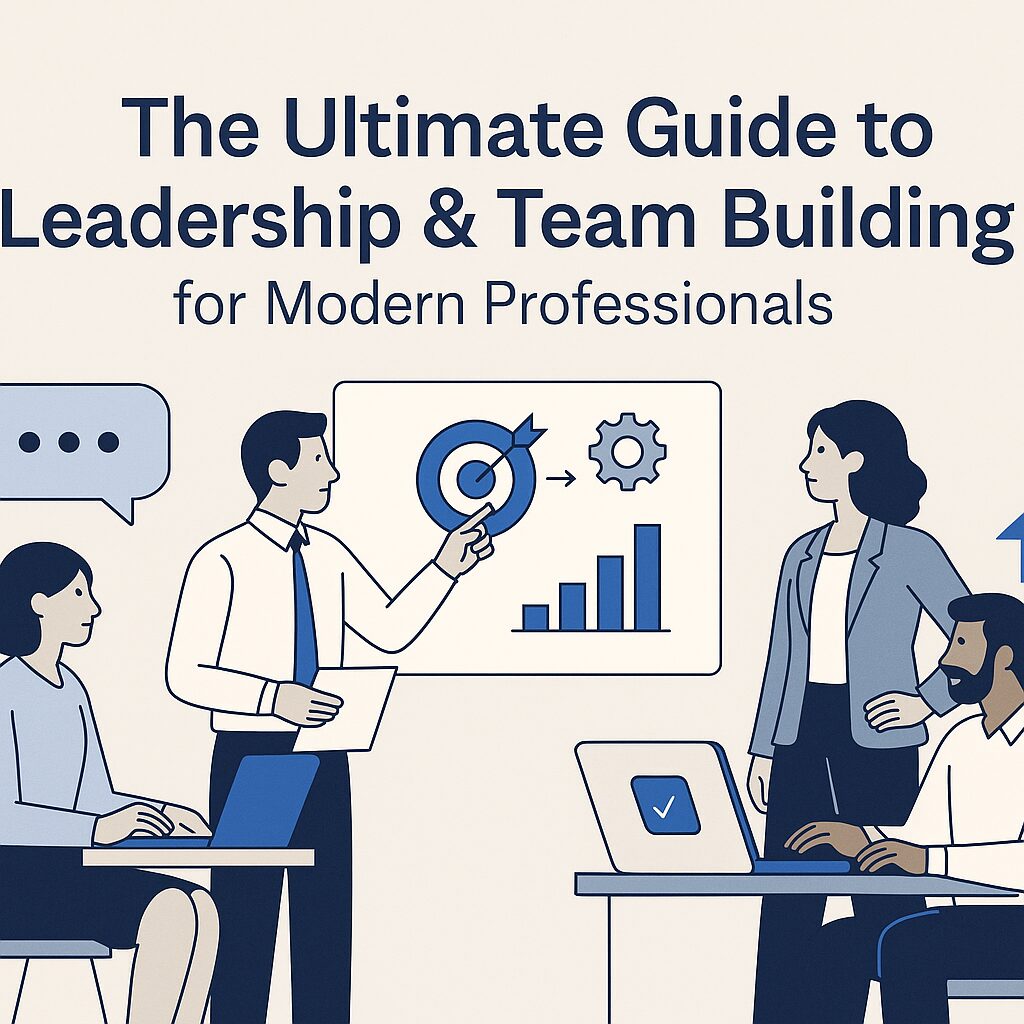
Leave a Reply